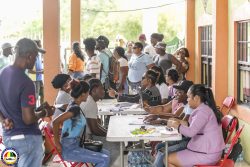Dear Editor,
In response to Mr Rajendra Persaud’s letter captioned, ‘The Musa Disease Management Unit has been working vigorously to serve plantain and banana farmers’ published in the Stabroek News of January 17, I wish to make the following points:
1. I see no misconceptions in the Stabroek News article: ‘Plantain farmers count big losses after disease outbreak’ (SN, January 16). The photographs are clear. They tell the story of the suffering of the farmers.
2. Honesty on the part of the professional, Mr Rajendra Persaud, would at the very least cause him to admit that the disease Black Sigatoka was discovered to be a threat to the local plantain and banana industries as early as 2005. Another professional, Mrs McAllister was the officer leading the investigation into this development in the Waini River community in Region One at the time. Mr Persaud would also admit that, the absence of funding was the stated reason for the abandonment of this exercise.
3. There was in fact no mapping exercise or inventory of plantain and banana farmers done by the Ministry of Agriculture up to the end of December 2009. In fact, the field officer in charge of Region Three, Mr Warde died in an auto accident in December, 2009 before he could complete the work he was in the process of undertaking. Since then, nothing has been done in this regard.
4. For Mr Persaud to suggest that, with a team of eighteen officers, his unit could achieve 75% completion of a nation-wide survey must mean that there were no holidays in a 24 hour-a-day unit operation totally utilising the full staff complement in a top secret operation which started less than a month ago.
5. Does it not bother Mr Persaud that he chose the areas he did to set up ‘demonstration plots’? How beneficial will these be to the wider cross-section of farmers? That is of course assuming that they have been set up in all affected regions. My information is that no such plots exist in Region Three.
6. For Mr Persaud’s information Ruby Back, Tuschen Back, Zeelugt Back and Canal Polder farmers know nothing about training, brochures or demonstration sites. I have taken the time to check this for myself.
Mr Persaud is duty bound to tell the farmers and other stakeholders in the industry, when and where these training sessions of which he wrote took place.
Farmers may also be interested to learn where and how they could obtain copies of the brochures of which he wrote, since the farmers with whom I spoke were neither invited to such sessions nor were they fortunate to receive brochures.
Editor, Guyana has messed up in a major way in the handling of this Black Sigatoka matter. The blunders are numerous. Below, are a few examples:
1. The Ministry of Agriculture failed to utilise the services of Dr Raghunauth Chandranauth, a Guyanese, who resides in Guyana, and who is in the employ of the said ministry. Dr Chandranauth known to farmers as Dr Keri, is an expert in the area of pests. Instead, the two experts retained were from Suriname and India. The Indian consultant challenged the report of the Surinamese consultant. You will recall that, following the report of the Surinamese consultant, the Guyana-Suriname ‘back track’ route was closed.
2. Following the exit from office of both the Principal and Deputy Principal of the Guyana School of Agriculture (GSA) in the course of 2009, Dr Chandranauth was asked to perform the functions of principal of that institution while still being substantively employed at the National Agricultural Research Institute (NARI).
3. The ministry attempted to subtly cause the diversification process to commence and conclude without any alarm bells being sounded about Black Sigatoka. To this end, free ducklings, black belly sheep and seeds were distributed to select farmers who were encouraged to move away from plantain and banana farming for the lure of the faster dollar which they were told ducks and sheep offered.
4. There was no action taken by the Agriculture Ministry officials to deal with this Black Sigatoka issue between its discovery in 2005 and late 2009. This is despite the fact that I first made it public in 2008.
Unlike the Minister, Mr Robert Persaud, his officers are not visible in the fields. On Thursday, January 7, 2010, the Minister told me that he got a report that a team of his people visited the Rosenanti farmers the day before. I later checked that out and advised him that that was not true since I spoke with the farmers and they never benefited from any such visit.
On the other hand, when I made representation to the Minister for some works to be done in two farming communities, he immediately dispatched the CEO of the National Drainage and Irrigation Authority to visit with me and have discussions with members of those communities.
On the spot assessments were done and within weeks recommended works commenced. Works concluded on schedule and to the satisfaction of the beneficiaries. The Minister then visited to check those works.
Editor, I am convinced that, had the Ministry of Agriculture officials operated appropriately, providing necessary information and carefully researched reports the Minister would have been in a better position to make appropriate and timely interventions.
As of now, political spin-doctorism must be their choice and only available smokescreen. Meanwhile, the Minister appears to be in the dark and the farmers continue to suffer.
Yours faithfully,
Mervyn Williams, MP







